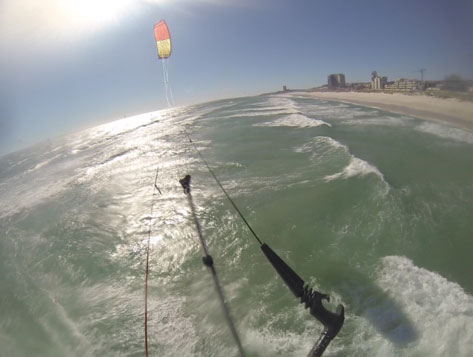Line length
With a different line length you can easily and effectively change the flying characteristics of a kite. And the boardway line service gives you the possibility to do this with extension lines or by making a line set in the desired length. But there is still a lot of ignorance in this area. And a few legends have become established, which we would like to dispel.
First of all, let us look at the different wind windows with lines of different lengths. As we know, a wind window corresponds roughly to a quarter of a sphere, the radius of which is a line length. So the shorter the line, the smaller the wind window. An example of calculation: If we assume a wind window of 180 degrees and reduce our line length from 27 to 25 metres, the kite only has to fly 76 metres from left to right instead of 85, a proud nine metres less. With 20-metre lines, it is even only 63 metres, another 13 metres shorter distance. Not only the wind window becomes smaller, consequently also the power zone and soft zone.
Legend 1: Short lines make the kite faster
No, a kite does not get faster with short lines. Especially if you refer "fast" to the turning speed. In fact, many will feel that the kite turns faster on long lines. Since the wind window is much smaller with short lines, you also have less space to steer the kite. If you choose long lines, on the other hand, you can fly wild figures in the sky. The flying speed naturally feels greater with short lines, as the kite has a shorter path through the wind window. Since every steering movement has a faster effect on the position in the wind window, this gives a very direct flight feeling.
Legend 2: Short lines are better for gusty winds
You often hear that short lines are better for gusty winds. However, this is not necessarily true. It is true that gusts can be slowed down much faster due to the smaller wind window, but in the wind holes the kite also falls further back in the wind window. If the next gust comes, you get a lot of pressure at first and brake the kite quickly through the lines. The kite shoots forward, where the pressure to continue after the gust can sometimes be missing. Put more simply: The kite wriggles back and forth more. Thus, in inconsistent conditions, a kite on short lines often feels rougher than the same model with long strings. And on top of that, a kite on short lines is more unstable. Here, the golden mean is often the right choice: easy to brake, but not too sensitive to wind holes.
Lines and wind range
Short lines for storms and long lines for light winds, generally we agree with this rule of thumb. It is not without reason that kite schools in many strong wind areas often train with short lines. Long lines in a storm are not really fun either. The kite is harder to brake out because the paths become longer. So you have to stand on the edge longer until the kite loses pull. But if you ride slowly, fly the kite low and brake the board to the maximum, the line length doesn't make much difference for the upper wind range. Nevertheless, the short lines are often more fun when fully blown, because should you ever get too fast, you can react better with the edge. It is also true that a kite with short lines starts later. In the lower wind range of a kite, you often only have enough pressure to kite because the driving wind adds to the stationary wind. You can see this especially with some light wind kites or snowkiting. On hard snow, it is even possible to run upwind before a kite is even flying properly, and when you then get going, you suddenly have an astonishing amount of pressure. With long lines, the path through the power zone becomes longer, giving the rider more time to get on the board and build up enough speed. Thus, you can already be planing and have enough airstream before the kite leaves the power zone. Of course, there is also the effect that there is often more wind at higher altitudes and the kite is inevitably flown higher with long lines.
Sporty
Kitesurfing becomes more "radical" with short lines. The kite feels more direct because you notice a change in pressure in the kite more quickly after a steering impulse. Many tricks become more difficult with short lines because you fly the kite faster into an area of the wind window where you have too little or too much pressure, or you under jump it faster. You can take advantage of this with one trick in particular: the kiteloop. With radical and high loops, it is often a matter of looping the kite as far as possible in the power zone, preferably still under the kiter, in order to get maximum lateral acceleration. If you then still want to stand the jump, the kite should be back up in time to catch the rider.


